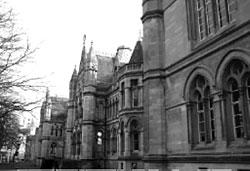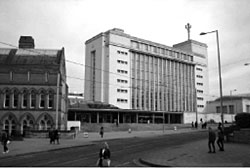Articles from the Thoroton Society Newsletter
A gap in the market
By George Murfet

The Arkwright Building of Nottingham Trent University (Photo George Murfet).
In the nineteen fifties & sixties in the East Midlands, the success of textile fabric manufacture and garment making and the colouration, by commission dyers & finishers, brought welcomed relief to a working community that had witnessed the contraction of the industries and the amalgamation of companies during the war years. This increase in production, if not in productivity, meant an increase in the labour force, with the chance of a better career structure and the opportunity for personal development. Within Nottinghamshire, the most important source of textile educated technicians, technologists and managers was from within the Arkwright building, on Shakespeare Street. Originally intended to provide secondary education to school leavers (aged 13+), the building initially accommodated the University College students until they were later transferred to purpose-built facilities at the University Park in 1928; where, as the University of Nottingham, it was able to award its own degrees (1948). By that time, the fine neo-gothic Arkwright building (b. 1881) had survived the Luftwaffe bombing of May 1941, even if the textile, and the mining, departments were damaged; and by then known as the Nottingham & District Technical College (1945). That college progressed, incurring a multitude of name changes – Regional College, Trent Polytechnic and Nottingham Polytechnic – until ultimately becoming, as a result of the amalgamation of many separate institutions of higher education, the Nottingham Trent University (NTU): but is still affectionately known as the ‘tech or the poly’.

Nottingham Trent University’s Newton Building (Photo: George Murfet).
In 1958, after the demolition of a bakery and other buildings on Burton Street - Goldsmith Street, the college expanded (upwards) with the highly noticeable, multi-storey, Newton building which hardly blended into its surroundings. During the last quarter of the 20th century, and following the millennium, the whole of Shakespeare Street to the west, reaching up to the old Art College (1843 School of Design), became more of the NTU. These buildings, together with the refurbished Newton building and the introduction of the tram system on Goldsmith street, then made the (1888) Guildhall, sadly, the building out of keeping with its surroundings.
In 1925, the Textile Institute (TI) in Manchester was award a Royal Charter and such to the Society of Dyers & Colourists (SDC) in Bradford came in 1963. Over many years, both the TI and the SDC organised a full programme of lectures, not only throughout the country but on an international basis. Most of those given in Nottinghamshire were from within the Arkwright building where Cyril Edwards, head of the textile department and Dr Bill Lead, head of the dyeing department, both from an industrial textile background, ensured a fruitful reciprocal arrangement with the senior staff members of the local textile industry, that brought mutual benefit to all concerned.
The examinations of the TI and the SDC were always for the associateship qualification (ATI or ASDC), but for those who did not entirely complete the examination the Textile Institute awarded the licentiateship (LTI) diploma.
The TI published two journals: one for all members and another for those interested in research, needing an additional subscription. The SDC did neither. As far back as the 1880s, there was criticism that its published papers were “too theoretical” and should be “more technical than scientific”. Similar comments were being heard a hundred years later but, in defence of the Society, it must be admitted that the highest standards it maintained in all aspects of its work, including the publications, have given it a prestigious place in worldwide coloration activities. Some believe that the SDC paid a high price to maintain this policy and, unlike the TI, its licentiate-ship (LSDC) arrived too late. Inevitably, many of those who failed the SDC examination declined to pay further subscriptions, if without any qualifications, and equally did not attend SDC evening lectures.
The most circulated colouration magazine was undoubtedly that from the International Dyer publisher, although many other trade magazines, and the TI’s own journal, included dyeing, finishing & printing articles. ‘The Dyer’ was popular and read by technical and managerial staff members. The journal of the SDC continued to demand a parent doing likewise. It seemed that the whole dyeing & finishing community in Nottingham revolved around the Arkwright building and the academic staff knew and tertiary educated those who were within the industry. With this immense amount of communication available yet another rival believed that it saw a gap in the market.
In 1965, there existed in Leicester the ‘Guild of Technical Dyers (Leicester Local Centre)’ representing dyers & finishers in the textile trade who were essentially of a practical disposition. The guild arranged, with some success, lectures, outings and social events. A chance conversation by one of its enthusiastic members (Bill Brookes) aroused a similar idea in the mind of a Nottinghamshire member (Geoff Whitehead) of the trade. The idea was circulated (Frank Swift) to potential members and soon the suggestion of a Nottingham Local Centre, attached to Leicester, was formulated. Progress foundered but, undeterred further measures were taken with a meeting at the Red Lion (RL) Hotel, Cinderhill on the 30th of November at which 20 people, representing 12 companies, were present. A committee was formed and met the following January, higher understanding of chemistry, in particular, and was read by fewer employees, including those who had passed its own examinations.
In the 1960s, in particular, there was a seemingly inexhaustible thirst for industrial knowledge that demanded external lectures in the evenings and during Saturday mornings. The SDC’s Midland Region even formed two junior sections, one in Leicester and the other in Nottingham, each arranging a series of lectures and its discussing rules, subscriptions, membership and the frequency of meetings: the names of 30 companies being listed. Eventually, ‘going it alone’ became its reluctant decision when the Leicester Guild spurned further thought of unification; and so created by default the ‘Nottingham & District Society of Technical Dyers’(NDSTD). At a General Meeting on the 26th January at RL, 94 signed the attendance book, being from 37 companies and one from the ‘tech; many failing to gain entry. The overwhelming response caused it to be said that the Leicester Guild “were bemused” and the SDC “wary of the new organisation”.
The inaugural meeting, attended by 80, was in February 1966 with a lecture from L Boardman of Geigy UK, the dyestuff manufacturers. Thereafter, monthly lectures, of a practical nature, followed to audiences of up to 104, necessitating a venue change to the Whitemoor Hotel in Bulwell. Technical visits to Courtaulds’ Viscose plant in Preston and the Yorkshire Dyeware & Chemical company in Leeds were followed by a golf match against the Leicester Guild, a skittles evening at the Whitemoor Hotel, a cricket match against the Breaston Cricket Club and a dance (175 tickets sold) at the Blue Ball, Risley. The autumn lecture programme followed the first in similar vein and by January 1967 a dinner dance, at 30/- each, had attracted 118 in attendance. At the January AGM, it was reported that lectures then averaged 70, from a membership fgure of 129, which caused a decision to change the headquarters to the Apollo Hotel, Bulwell. At the meeting, the secretary and treasurer both declined any form of honorarium. A compliment was paid to the NDSTD when a rival organisation proposed a joint meeting of local societies to discuss rationalising all the lecture programmes: the meeting never taking place.
By the time of the AGM in January 1968, the Society had fully established itself with 136 members, and attractive lecture programmes and technical visits, which always pulled in additional social opportunities on the drive home. Perhaps with that in mind, the society took its one and only false step. A proposal that ‘Membership of the Society be restricted to male persons only’ was carried by 22 votes to 11. The vote opened a food-gate of abuse in the national press and by telephone during the February. Once the matter was rescinded, normality prevailed. The confrontation was only ever taken up by two women and when, much later, it was suggested that two tickets should be given to one of them for the Annual Dinner Dance it is recorded that that there was no support for the suggestion. In June 1968, 20 society members travelled to Farbenfabriken Bayer AG, Leverkusen, West Germany for the first of its overseas technical visits and in the May of 1969 held a function for the ladies with ‘a Hair Styling Demonstration by Stanley Barber’, a significant first on both counts.
As from then on, the NDSTD, having clearly set out its modus operandi, provided its members with an entertaining and interesting programme of varied events that more than matched its rivals. In 1965, it had seen that what the Leicester Guild of Technical Dyers was offering ought to be replicated to those in the textile dyeing & finishing trade in Nottinghamshire. There was an obvious social gap in the market and it should be filled. What it didn’t see was the forty year limitation to its intentions; and if it had it would still have gone ahead with its ideas. Through 1974-2004, the multi-fibre arrangement governed the world textile & garment trade imposing quotas on the amount developing countries could export to developed countries; although the EU imposed no restrictions, or duties, on imports from emerging countries. The World Trade Organisation’s agreement on textiles & clothing provided for the gradual dismantling of the quotas that existed under the MFA, a process that was concluded by January 2005 but which didn’t produce the smooth transition that was envisaged, as imports exceeded all expectations.
As a result, the euphoria very gradually diminished as textile manufacturing declined in Nottinghamshire, the dyeing & finishing services followed suit and the social groups disappeared, e.g. the Nottingham Textile Society. The NDSTD’s Annual Dinner that attracted over 200 diners fifteen years ago now struggles to find a quarter of that number whilst lecturers cater mainly for the retired. Whether it was apparent years ago, matters not. Courses are not now available for teenagers, even if they could be persuaded, to follow textile technology or textile chemistry into the industry that served most of us reasonably well; but, alas, once the industry went, so did the fraternity and fellowship that proved so valuable for some many.
< Previous